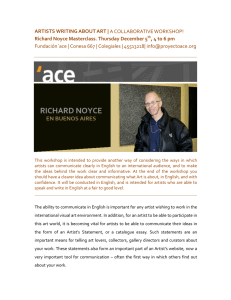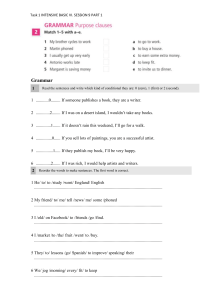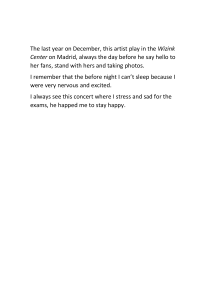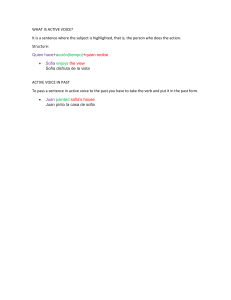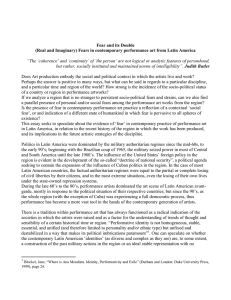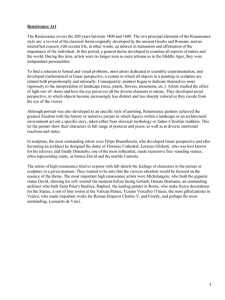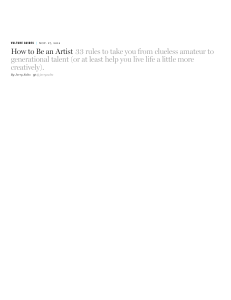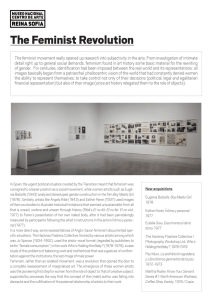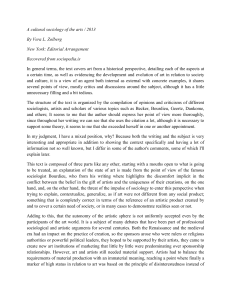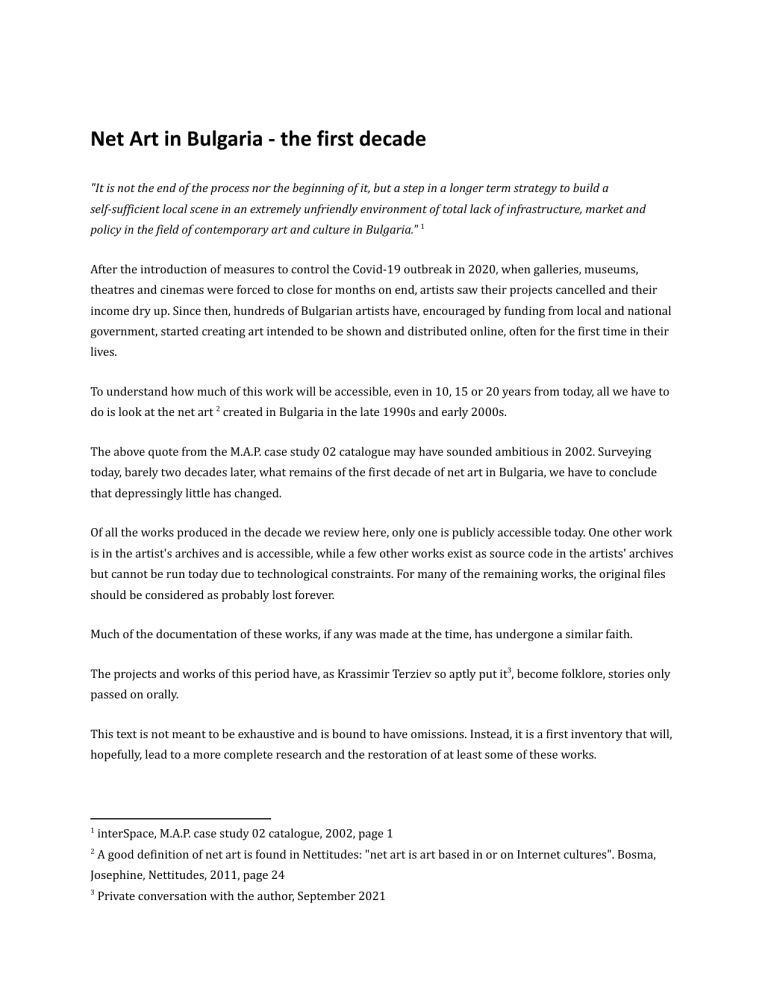
Net Art in Bulgaria - the first decade "It is not the end of the process nor the beginning of it, but a step in a longer term strategy to build a self-sufficient local scene in an extremely unfriendly environment of total lack of infrastructure, market and policy in the field of contemporary art and culture in Bulgaria." 1 After the introduction of measures to control the Covid-19 outbreak in 2020, when galleries, museums, theatres and cinemas were forced to close for months on end, artists saw their projects cancelled and their income dry up. Since then, hundreds of Bulgarian artists have, encouraged by funding from local and national government, started creating art intended to be shown and distributed online, often for the first time in their lives. To understand how much of this work will be accessible, even in 10, 15 or 20 years from today, all we have to do is look at the net art 2 created in Bulgaria in the late 1990s and early 2000s. The above quote from the M.A.P. case study 02 catalogue may have sounded ambitious in 2002. Surveying today, barely two decades later, what remains of the first decade of net art in Bulgaria, we have to conclude that depressingly little has changed. Of all the works produced in the decade we review here, only one is publicly accessible today. One other work is in the artist's archives and is accessible, while a few other works exist as source code in the artists' archives but cannot be run today due to technological constraints. For many of the remaining works, the original files should be considered as probably lost forever. Much of the documentation of these works, if any was made at the time, has undergone a similar faith. The projects and works of this period have, as Krassimir Terziev so aptly put it3, become folklore, stories only passed on orally. This text is not meant to be exhaustive and is bound to have omissions. Instead, it is a first inventory that will, hopefully, lead to a more complete research and the restoration of at least some of these works. 1 interSpace, M.A.P. case study 02 catalogue, 2002, page 1 2 A good definition of net art is found in Nettitudes: "net art is art based in or on Internet cultures". Bosma, Josephine, Nettitudes, 2011, page 24 3 Private conversation with the author, September 2021 Beginnings It was November 1997 when a group of Bulgarian artists travelled by bus from Dessau in former Eastern Germany to Sofia. In the days before, the group participated in the OSTranenie 97 festival. One of the artists in the group, Petko Dourmana, had presented his work Metabolizer during the festival. Image petko-dourmana-metabolizer-1997.jpg Caption: Metabolizer Artist: Petko Dourmana Developer: Pavel Kodjabashev Year: 1997 Status: The work is not currently publicly accessible. The source code is in the artist's archive but has dependencies on legacy software (Cosmo VRML player) that modern operating systems no longer support. Metabolizer was originally conceived as a multi-user interactive installation. It was intended to be projected on a large screen, accompanied by a large-scale sculptural element and a soundtrack recorded in a body-building gym. Financial constraints were the reason the sculptural elements were never realized. At the same time, technical limitations - the only technology available to the authors at the time to create the multi-user interaction, were web-based - meant that, by accident rather than by design, Metabolizer became Bulgaria's first work of net art. Metabolizer consists of an image of the body of the artist, which participants could manipulate by injecting hormones, drugs, proteins, vitamins, and other substances. Multiple viewers see the same image and see each other's actions. They can chat with one another via built-in chat, so they can coordinate (or counteract) their manipulations. Iliyana Nedkova, a Bulgarian-born curator who worked at the time at the Foundation for Art & Creative Technology (FACT) in Liverpool, wrote in the catalogue of Ostranenie 97 about the work: "Metabolizer could easily recall Stelarc's vision of the body as a host of new technology and his way of deconstructing Western metaphysics about the self and the internet as affecting the human body physically rather than being merely a tool for transmitting information." 4 4 Nedkova, Iliyana, Ostranenie catalogue, 1997, page 146 The work is also meaningful against the backdrop of Bulgaria at the time, with its society in transition and former regime structures using hired muscle from local sports schools to secure their positions of power and money. Cyberknitting During the Ostranenie 97 festival, Nina Czegledy initiated the Cyberknitting event. Czegledy is a Canadian artist, curator and writer whose work focuses on international art, science and technology collaborations. Feminist art critic Katy Deepwell described the Cyberknitting event in an article she published in the international feminist art journal n.paradoxa later that same year as follows: "Cyberknitting (for men and women) is an attempt to build upon the convergence and/or discrepancy of: 1. Knitting: as an ancient activity, usually practised by women and lately by men (ref. to primary meaning of: to weave/purl/crochet/hook/knot/intertwine/braid/sew yarn into fabric, with needles) 2. Cyberknitting: as a recent activity of networking within the Internet, usually practiced by men and lately by women (ref. to the metaphorical meaning of: to draw together and join closely, to spin a story." 5 Among the participants in the event were Inke Arns, Nina Czegledy, Calin Dan, Katy Deepwell, Tapio Makela, Edi Muka, Iliyana Nedkova and Erika Pastor. In their presentations, the participants looked at the newly-found ways of networking that the Internet, which had only become accessible to the general public a few years earlier, made possible through the lens of knitting, with all its social and gender implications. In her presentation, Iliyana Nedkova argued that Cyberknitting could be seen as "a different metaphor for the 'information super-highway; one which emphasised relationships and connection between people, rather than technological development. 6 Inspired by the presentations and discussion at Ostranenie, the conversation in the bus on the way back to Sofia turned to the need for an artist-run media art organisation in Bulgaria. A year later, this conversation would lead to the birth of interSpace, which went on to play a leading role in media art production and presentation in Bulgaria for the next decade. 5 Deepwell, Katy, Cyberknitting event at Ostranenie, n.paradoxa, Issue no. 5, 1997, https://www.ktpress.co.uk/pdf/nparadoxaissue5_katy-deepwell_12-16.pdf 6 Deepwell, 1997 Virtual Revolutions: The Doppelgaenger Revolution In the spring and summer of 1998, a series of four media art workshops were held at the Soros Center for the Arts (SCA, Sofia), V2_ (Rotterdam, the Netherlands), Polar Circuit 2 (Tornio, Finland), and Revolting (Manchester, UK). The workshops were part of a larger project, which started at Video Positive 97: Escaping Gravity at FACT in Liverpool and ended with the publication of a CD-ROM entitled VR: ACT and READ7 in 1998. At the time of this writing, an effort is underway to make the CD-ROM content accessible again as an online archive. The Virtual Revolutions project reflected on "the recent transformations in Eastern and Central Europe and the shift of our east/west perceptions in the 1990s"8 and was initiated and curated by Iliyana Nedkova, with co-curators Mare Tralla and Nina Czegledy. One of these four Virtual Revolutions workshops was held at the V2_Lab in Rotterdam in late June and early July 1998. The theme of the workshop was Doppelgaenger Revolution, questioning personal identities in virtual environments9. Among the participants was Bulgarian artist Dimitrina Sevova, who created and published her first net art work during the workshop. This work, the second Bulgarian work of net art and the first net art piece by a female Bulgarian artist, has since been lost. No documentation appears to even exist. Wartime By March of 1999, the war in Kosovo had led to a sustained aerial bombing campaign against the Federal Republic of Yugoslavia by NATO. Networks and mailing lists like Syndicate and Nettime which media artists had used since the early and mid-90s to exchange ideas and communicate, became a lifeline used to share what was going on "on the ground", to bond and share hope for a more peaceful future. 7 Nedkova, Iliyana, JUST RELEASED: NEW PUBLICATION - VIRTUAL REVOLUTIONS: ACT and READ // ACOUSTIC.SPACE, 2000, 3, http://acoustic.space.re-lab.net/vr-cdrom.php 8 Nedkova, Iliyana, Video Positive 97: Escaping Gravity catalogue, 1997, page 33 9 Announcement sent by Andreas Broeckmann to Nettime mailing list on 27 June 1998, https://nettime.org/Lists-Archives/syndicate-9806/msg00064.html Bulgarian artist Luchezar Boyadjiev was working in his studio in Sofia, only a few hours drive from where the bombs were falling. While he spent most of his time in front of the computer, he received emails from friends and colleagues on both sides of the conflict. Feeling depressed by what he read, Boyadjiev says he created a series of 53 digitally altered self-portraits in response, using the image manipulation filters available in PhotoShop, trying to match his mood at that time. 10 Image luchezar-boyadjiev-eface-1999.png Caption: Eface Artist: Luchezar Boyadjiev Year: 1999 Status: In artist's archive. Several of these images were sent by email to his friends as a way of sharing his feelings. Boyadjiev saw the whole process as multiple translations between the real world and the virtual, as a "contamination between physical and virtual realities" 11. Designing the Future State of Balkania In November of 1999, Dutch Media Theorist Geert Lovink organised TEMP, a Temporary Media Lab that consisted of workshops, debates, a conference and presentations at Kiasma, the Museum for Contemporary Arts in Helsinki, Finland. TEMP was, in Lovink's words "a production facility that enables groups, networks and individuals working on the crossover between new media arts and social, political and economic topics to discuss, develop, and realize their projects." 12 10 Boyadjiev, Luchezar, E-FACE 2000 project documentation, 2000 11 Boyadjiev, 2000 12 Email announcement by Geert Lovink on the Nettime mailing list, https://www.nettime.org/Lists-Archives/nettime-l-9909/msg00057.html The TEMP workshops would bring together in physical space a group of artists from a virtual network, united around a theme. The group would work together, do regular public presentations and maintain a web journal in which it could experiment with ways and materials of reporting, and allow participation. The third workshop in this series consisted of a group of artists who also participated in the Syndicate network and mailing list. Syndicate was run by V2_East, and included "people and institutions who are involved in media culture and media art in Europe and who want to create contacts and an infrastructure for projects and cooperations." 13 The theme of the TEMP workshop at Kiasma was Designing the Future State of Balkania. Driven by events of the war in former Yugoslavia and Kosovo in the years before, a group of artists from the Balkan countries would re-imagine art in an imaginary future Balkan state and "investigate what would be needed to form a synthesis of conflicting historic views and colliding identities." 14 Bulgarian participants in the workshop were Anna Bocheva, Luchezar Boyadjiev, and Dimitrina Sevova. Although the goal of the workshops was the exchange of ideas, rather than to create new artworks, electronic and ambient musician Anna Bocheva collaborated with Croatian artist Darko Friz on a Flash animation. Image darko-fritz-anna-bo-ein-balkanier-1999.png Caption: Flash animation created for the Balkania website concept: Darko Fritz sound: Ana Bocheva programming: Vedran Gulin Goo Year: 1999 Status: Source code status is unknown. The Flash animation is publicly available but can no longer play on modern operating systems. The animation consisted of an image of the Dalai Lama, changing in quick succession between the normal and mirrored version of the image, overlayed with layers of text moving in and out of the frame. The words "future" and "past" move left to right and vice-versa across the screen, briefly leaving the word "life" on the screen where "future" and "past" had crossed. Meanwhile, the sentence "ich bin ein balkanier", a variation of JFK's famous 1963 Berlin speech, repeatedly jumps out from the background across the screen. 13 Arns I., Broeckmann A, DEEP EUROPE: THE 1996-97 EDITION, https://v2.nl/archive/articles/deep-europe-the-1996-97-edition 14 Lovink, Geert, 1997 The soundtrack that Bocheva created contains a mix of what sounds like tribal chants and dances, adding to the frenzy of the experience. Networking real spaces Between 1998 and 2006, the Fournos Centre for the Digital Culture organised an annual festival called International Art and Technology Festival medi@terra. In 2000, one of the works on show was called Schizoid Architectures. Shown on a desktop computer in a room, the work presented an online VR world of living rooms and other personal spaces of the participating artists. By moving the mouse, the visitor could explore the space and click on various places and objects to move from one space to another, creating connections between the rooms. Image krassimir-terziev-schizoid-architecture-2002.jpg Caption: Schizoid Architecture Artists: Krassimir Terziev, Petko Dourmana, Nikolay Chakarov, and Maria Berova Year: 2000 Status: Source code status is unknown. The work depends on technology that is no longer supported by modern operating systems. The concept by Krassimir Terziev, co-founder and one of the prominent members of interSpace at the time, was deeply connected to the experience of the Internet in those early years; you spend your days sitting in your room, in front of a computer, but somehow you are connected to and visit all these other places around the world. There was this very real sense of these virtual places you visited being in specific physical locations; a site from a neighbouring country would load faster than one that came from the other side of the world. Schizoid Architectures used photographic panoramas, which were turned into Virtual Reality spaces with the help of QuickTimeVR. Apple discontinued QuickTimeVR and dropped support for its file format in 2019. In October 2000, Schizoid Architecture was one of the projects Krassimir Terziev presented during the net.congestion festival in Amsterdam. 15 Net.congestion was a three-day festival devoted to new forms of micro-, narrow- and broad-casting via and made possible by the internet, otherwise known as streaming 15 Net.congestion programme, 2001, https://web.archive.org/web/20010119113900/http://net.congestion.org/programme.html#presentations media. After his presentation in Amsterdam, Terziev would travel to Montreal to meet with the Daniel Langlois Foundation, a meeting that would result in the M.A.P. cast study 2 project in 2001 and 2002. Blind date One of the locations of the medi@terra festival in 2000 was The Factory in the Athens' school of fine arts. This was the location of the premiere of a second Bulgarian net art piece presented that year. The work was a collaboration between 6 female artists, with a female curator. Its title blinddata.net was a spoof on the British TV show Blind Date as well as the online location where the work could be found. Image vania-valkova-cyber_refresh-2001.png Caption: Blinddata.net Artists: Maria Berova, Ana Bocheva, Antoanetta Ivanova, Dimitrina Sevova, Zornitsa Sofia, and Vania Valkova Year: 2001 Status: The work by Sevova is publicly accessible online today. That by Valkova is in the artist’s archive. The remaining works should probably be considered lost. In a presentation during the Curating New Media BALTIC Seminar in May the next year, the project's curator Iliyana Nedkova retold the origin of the project as follows; "Bulgarian culture of the 90s presents itself as run and governed by women artists and practitioners. Women dominate the curatorial network of artists and producers. Creative technologies are recognized as an elegant occupation that readily welcomes outbursts of intimacy and humour or urgency and immediacy. There is not just a love of experimenting, but there is a lust for blind dating technology. This rise of a network society of women has prompted me to curate remotely my first women-only net-based show. In search of giddy-romance or all-is-blind love, 6 women artists at the forefront of the generation dot-bg have come together to tell their own blind data stories at blinddata.net. [...] These are tales of the ones and zeros of digital romance. Each rendezvous with Mr PC inspects the new techno-language used for authoring in an internet environment." 16 16 Nedkova, Iliyana, Consolations for Curatorial Inadequacies, 2001, https://iliyananedkova.wordpress.com/talks/ The artists participating in the project were Maria Berova, Ana Bocheva, Antoanetta Ivanova, Dimitrina Sevova, Zornitsa Sofia, and Vania Valkova. Of the works included in blinddata.net, only that of Dimitrina Sevova entitled A Room of One's Own, has survived and is currently publicly accessible online. 17 Image dimitrina-sevova-room-of-ones-own-2001.png Caption: Blinddata.net Artists: Maria Berova, Ana Bocheva, Antoanetta Ivanova, Dimitrina Sevova, Zornitsa Sofia, and Vania Valkova Year: 2001 Status: The work by Sevova is publicly accessible online today. That by Valkova is in the artist’s archive. The remaining works should probably be considered lost. For A room of One's Own, Sevova worked together with Swiss/Bulgarian journalist Alain Kessi. The work drew from the Virginia Woolf essay with the same title, as well as the design and writing of the American online magazine Nerve.com. Repurposing the layout of Nerve, Sevova and Kessi tell stories of a female artist and her attempts to balance her private and professional life, between bedroom, kitchen and a private room on the net. Towers In late 2001, inspired by the September 11 attacks and discourse that followed, Bulgarian artist Petko Dourmana created his second net art work entitled Tower Chat. Image petko-dourmana-tower-chat-2001.jpg Caption: Tower Chat 17 code flow museum - blind dating technology, http://www.code-flow.net/museum/blind_dating_technology.html Artist: Petko Dourmana Developer: Sergey Petrov Year: 2001 Status: No longer publicly accessible. Source code is in the artist's archive but has dependencies on legacy software that no longer runs on modern operating systems Like his first net art piece Metabolizer three years earlier, the themes of society building, peer pressure, and adhering to group norms to fit in, continue in this work. Like Metabolizer, Tower Chat was an interactive multi-user environment. On the openings-page of Tower Chat, Dourmanaa described the project as being "based on a very simple idea; speaking with each other, exchanging words and ideas people build or destroy something. In the concrete case, this is a 3D tower and you can make an analogy with the Bible legend for the Babylon tower that the people tried to build and to reach God or rather the perfection He symbolises. Some specifically chosen words used in the chat window build or destroy this tower. This tower can be infinitely high or never be built." 18 The server would monitor the chat between users against a predefined dictionary of words that have a positive or a negative connotation. Usage of negative words in the chat would destroy the tower in the site's visuals, while positive words in the chat would reconstruct the tower. M.A.P. case study The M.A.P. case study project came out of a meeting Krassimir Terziev had with the Daniel Langlois Foundation in the fall of 2000. The project was run by interSpace and lasted for 1 year between 2001 and 2002. Over the year, 10 Bulgarian artists were commissioned to produce new media art works. Participating artists in the project were: Maria Berova, Nikolay Chakarov, Petko Dourmana, Daniela Kostova, Ivan Mudov, Boriana Pandova, Andronia Popova, Peter Raichev, Zornitsa Sofia, and Krassimir Terziev. M.A.P. case study included three net-based works: Hunter of City Animals by Maria Berova, SMS Story by Nikolay Chakarov, and Life, Art Traveling, etc by Petko Dourmana. 18 Dourmana, Petko, 2001, https://web.archive.org/web/20020806202629/http://www.socializer.org/chat_login.php3 Image Caption: Hunter of City Animals Artist: Maria Berova Year: 2002 Status: No longer publicly available. Source code status is unknown. The work has a dependency on legacy software, which is no longer supported by modern operating systems. Bulgarian art historian Diana Popova describes Hunter of City Animals in the M.A.P. Case Study catalogue as follows: "A different aspect of the parallel lives in the city can be seen in Maria Berova's web project. In Hunter of City Animals, the energetic advertisements announce "They are strong and brave" and so on - i.e. as if taken out of any Saturday night action movie on TV. And at the same time the shots display the panic-stricken subject of advertising and the hunter: a shaggy dog is running, tail between its legs, to hide, a terrified cat is tiptoeing away.. The constant and unresolvable problem of the city - stray animals, an issue every now and then igniting society, dividing it and authorities for and against. And so on and so on..." 19 Image nikolay-chakalov-sms-story-2002.png Caption: SMS Story Artist: Nikolay Chakarov Year: 2002 Status: No longer publicly available. Source code status is unknown. SMS Story by Nikolay Chakarov consisted of a web-based interface and a backend that sent SMSes. The work's homepage contains the following description: "The first SMS that is sent to the participants in the project is the sentence "Once upon a time". To understand how the story continues, participants select 1 out of several possible options shown at the bottom of the screen." Image Caption: 19 Popova, Diana, MAP - Case Study 02 in MAP - Case Study 02 catalogue, 2002 Life, Art Traveling, etc Artist: Petko Dourmana Year: 2002 Status: No longer publicly available. Source code is in the artist's archive. Life, Art Traveling, etc, was a series of video interviews conducted by Petko Dourmana during his travels in the UK, with local media artists. The work was presented as a streaming-based website, as well as a video installation. ICA London In the early 2000s, the Institute of Contemporary Art (ICA) in London had a New Media Centre, consisting of a small room between the library and the coffee bar, where several workstations were installed that were used to show media art works. Petko Dourmana was in the UK in early 2002 where he did a presentation about interSpace and interSpace projects in Huddersfield. At this presentation, he met one of the ICA curators, who invited him to do a presentation in the New Media Centre. The only time window that was still open was August that year. And so, on 17 August 2002, an exhibition with works from artists and engineers who were members of interSpace was opened at the New Media Centre of the ICA in London. The exhibition included Life, Art, Traveling, etc by Petko Dourmana, shown as an online streaming project, Unconscious by Nikolay Chakarov and Webolution by Maria Berova. Image Caption: Unconscious Artist: Nikolay Chakarov Year: 2002 Status: No longer publicly accessible. Source code status is unknown. The project has a dependency on legacy technology, which is no longer supported by modern operating systems. Unconscious was a web-based project that challenged notions of conscious and unconscious choices. Image Caption: Webolution Artist: Maria Berova Year: 2002 Status: Status: No longer publicly accessible. Source code status is unknown. The project has a dependency on legacy technology, which is no longer supported by modern operating systems. Webolution was a web-based project that contained a Temperature Creature; an artificial lifeform using cellular automata-like algorithms, that took weather forecasts as input. The creature's evolution depended on the temperature forecasts. Image daily-stats-2002-screenshot.png Caption: Dailystats Artists: Alexander Milanov, Elenko Elenkov and Ivan Ginev Year: 2002 Status: No longer publicly available online. Source code status is unknown. Also included in the exhibition was Dailystats, a project by Alexander Milanov, Elenko Elenkov and Ivan Ginev. Dailystats was a social network that allowed registered users to post short updates or statuses, resembling and pre-dating Twitter by almost 5 years. Which city is this Between 2003 and 2007, the Center for Advanced Study Sofia (CAS) and the Institute for Contemporary Art Sofia ran the Visual Seminar, a series of four seminars, each consisting of two resident fellow programs. The focus of the seminars was a study of the changing relationship between visual culture, art and social life, where visualization became the dominant visual code. Visual Seminar 2 in 2003 had An Eye For the Pale City as its topic, and one of the residents was Krassimir Terziev. Terziev's project for the Visual Seminar was titled Excuse me, Which City is This? and focussed on the breakdown of public urban spaces in Sofia, 15 years after the collapse of the Communist regime. The project consisted of three parts; an exhibition at the ATA Center in which he showed two two-channel video installations and a series of photographs, a video campaign of 30-second spots that were shown on video-billboard in Sofia subway, and an online project at cityscales.net. Image krassimir-terziev-which-city-is-this-2004.png Caption: Excuse me, Which City is This? Artist: Krassimir Terziev Year: 2004 Status: No longer publicly available. Partial source code in artist's archive. The project depended on technologies that are no longer supported by modern operating systems. When opening the website for Excuse me, Which City is This?, the visitor would see a black-and-white map of Sofia that was divided into squares. Each square consisted of an animated gif image, with words jumping out of the map as part of the animations. Clicking on a square would open a video, a slideshow or a QTVR environment. Part of the slideshows in the project was a collection of 100 photographs of abandoned cars in the streets of Sofia, under the title of 100 Points in Favour of Art in Urban Space. About these photographs, Terziev said "The cars are objects filled with micro-stories (containing evidence of owners, time period, geographical location, the current state of society). They are fixed permanently in their places thus shaping the face of city streets. In order to legitimise their presence and appease the concerned rational half of my intellect demanding an explanation at all costs, I recognised in them art works in public space (a hybrid between park sculpture and a gigantic long-term collective happening)." 20 The QTVR panoramas in Excuse me, Which City is This? were photocollages under the title The City of Dogs, which Terziev describes as: "A series of photomontages featuring mutant creatures (heirs of the street dogs) as the only element that unites all the areas and diverse spaces in the city. The photomontages are 360-degree photographic panoramas from the city centre (the park in front of the National Palace of Culture) and the city suburbs (housing estates Tolstoy and Druzhba) or of a collage of tourist landmarks, all inhabited by gigantic dogs (their height ranges from around 6 feet to the height of a building of 10-15 storeys). These inhabitants 20 Terziev, Krassimir, Excuse me, Which City is This?, Visual Seminar / Resident Fellows Program 2, 2002, page 13 are signs of nature’s revenge (the irrational) on culture (reason), and they awake all the fears generated by the feeling of guilt about the forgotten equilibrium, by the egocentrism and comfort of consumerist existence."21 Recession By 2004, Petko Dourmana had evolved the ideas from Metabolizer and Tower Chat into a new work, titled Out of Recession (SocioScan). Image petko-dourmana-socioscan-2004.jpg Caption: Out of Recession (SocioScan) Artist: Petko Dourmana Year: 2004 Status: No longer publicly accessible. Source code is in the artist's archive but has dependencies on legacy software that no longer runs on modern operating systems In Out of Recession, Dourmana "explores the erosion of the emotional communication in the real-life and its re-settlement in the virtual environment of the Internet" 22. Out of Recession consisted of a web interface and a modified IRC server. The server would analyse the chat in real-time. In Dourmana's description, the analysis was similar to a test for sociopathic disorders. Words from the chat and tagged by the analysis software as being typical of sociopathic or normal conversation were displayed using a Tree-map visualisation and projected on a large-scale screen. "[T]he SocioScan project is scanning and mapping the intellect, emotions, the normality or/and sociopathy of the “global brain”." 23 End of an era 21 22 Terziev, 2002 Dourmana, Petko, Out of Recession, 2004, https://sites.google.com/site/dourmana/projects/out-of-recession-socioscan 23 Dourmana, 2004 Starting in the early 2000s, several changes occurred that would have a profound effect on the art world in Bulgaria. Internationally, the focus - and with it, funding for - the art world shifted away from post-1989, the collapse of the regimes in Eastern Europe and East-West explorations. In Bulgaria, the "self-sufficient local scene" seemed further away than ever. International funding that was withdrawn in the run-up to Bulgaria joining the EU in 2007 was not replaced with local sources. Some of the artists, like Luchezar Boyadjiev, Krassimir Terziev and Petko Dourmana had managed to establish themselves by this time, but a different fate awaited most of the female artists. Anna Bocheva focussed on her music career and is now an established musician and DJ. Zornitsa Sofia became a successful film director. Others entirely left the art world, the notable exception being Dimitrina Sevova, who moved to Switzerland where she works as an independent artist, curator and researcher. It would be 6 years later, under completely different circumstances, that the next Bulgarian net-based work, Oleg Mavromati's Ally/Foe, would appear. Tags ● Digital art ● Net art ● Mail art
